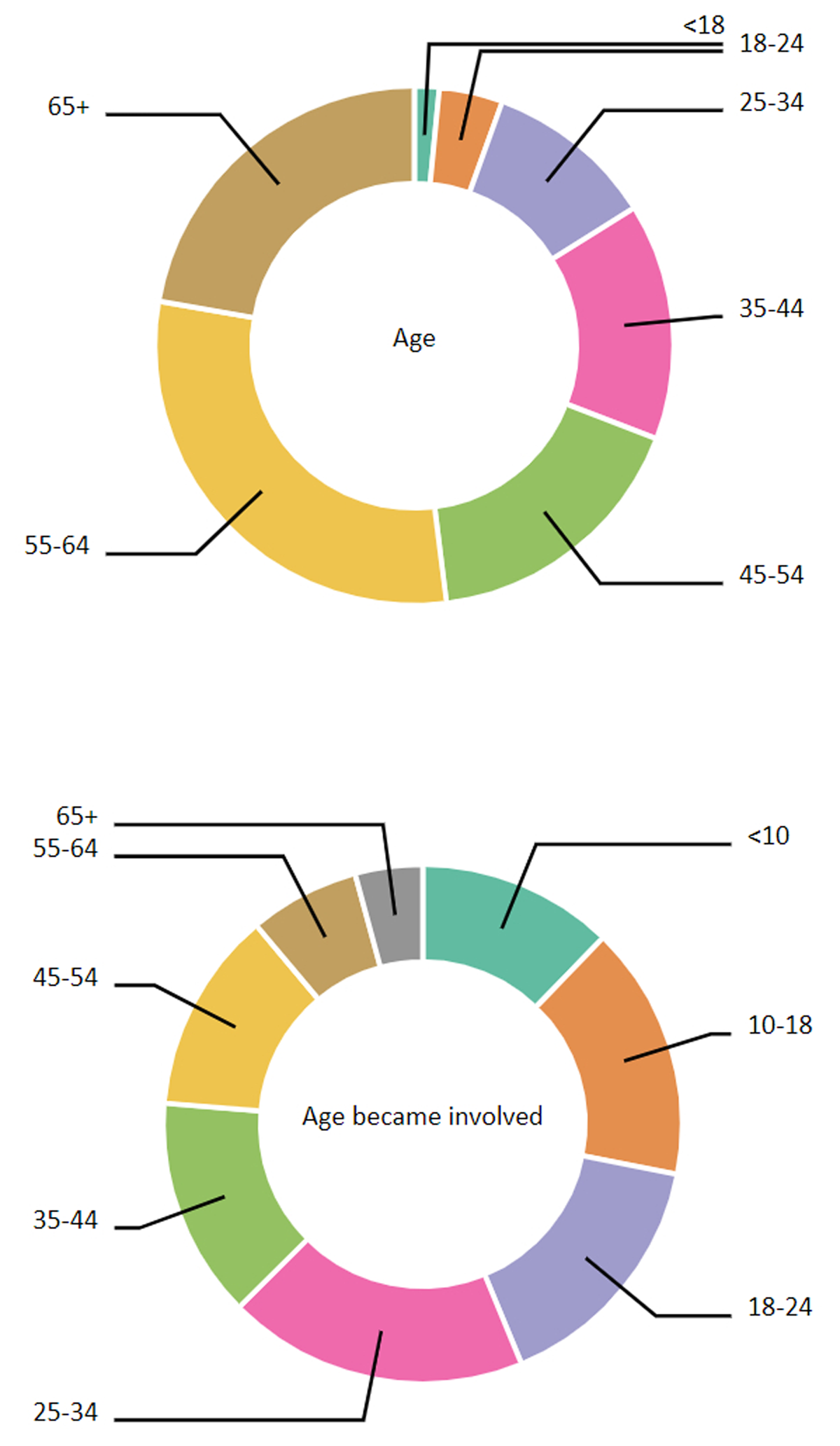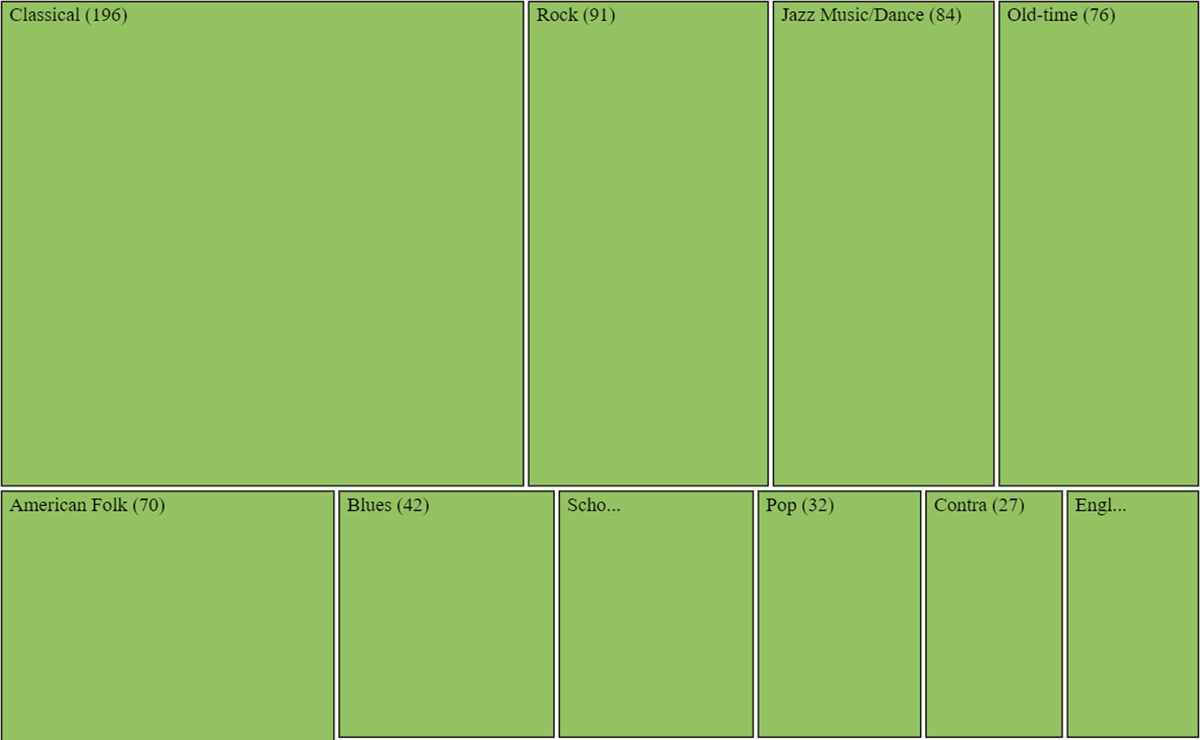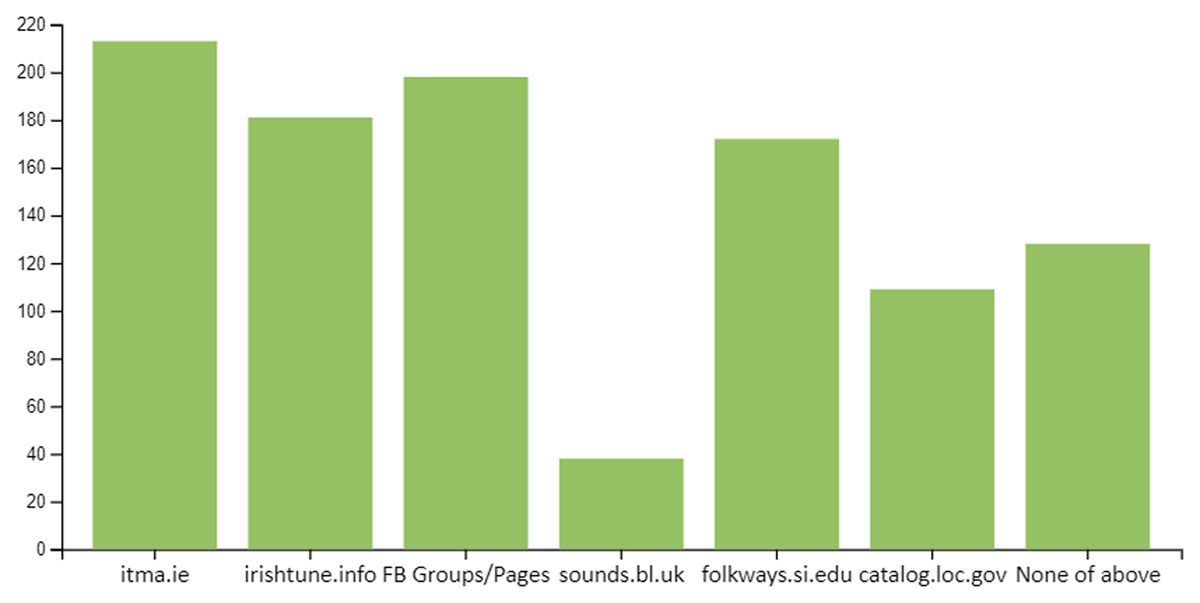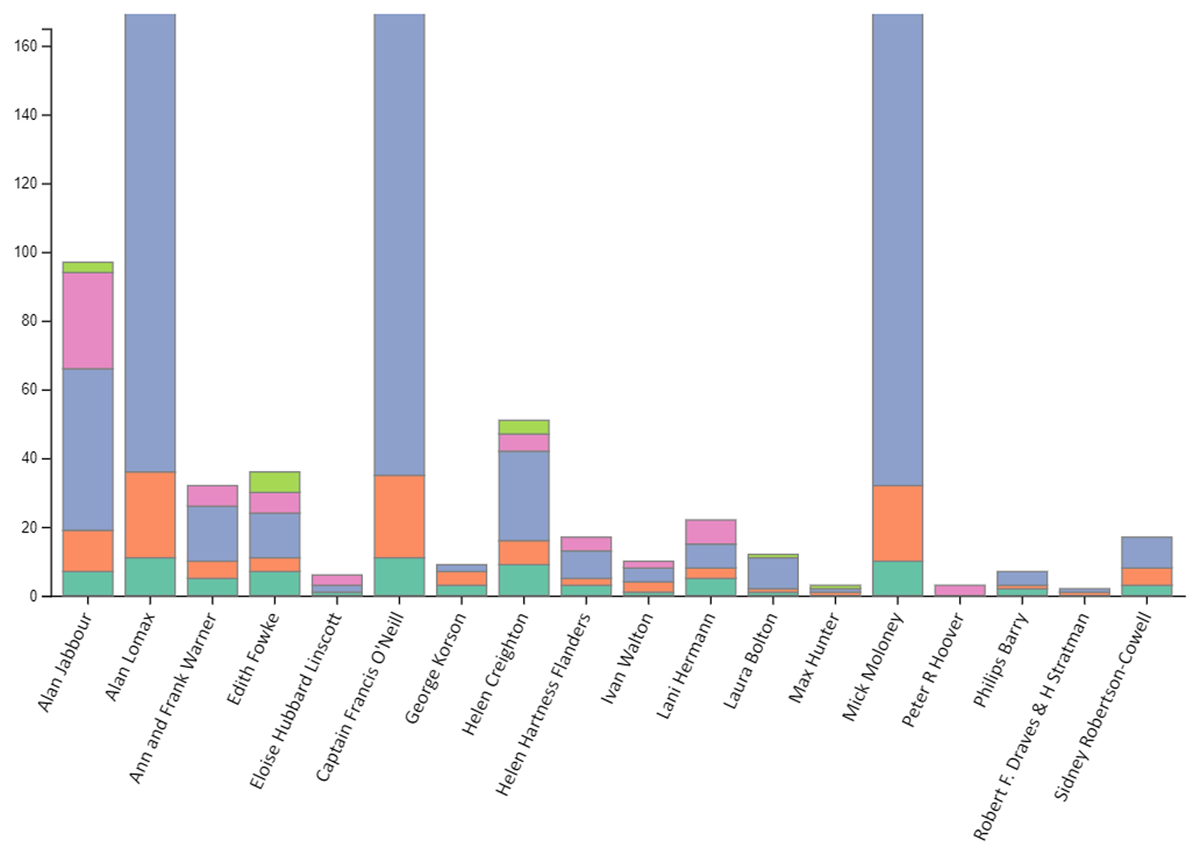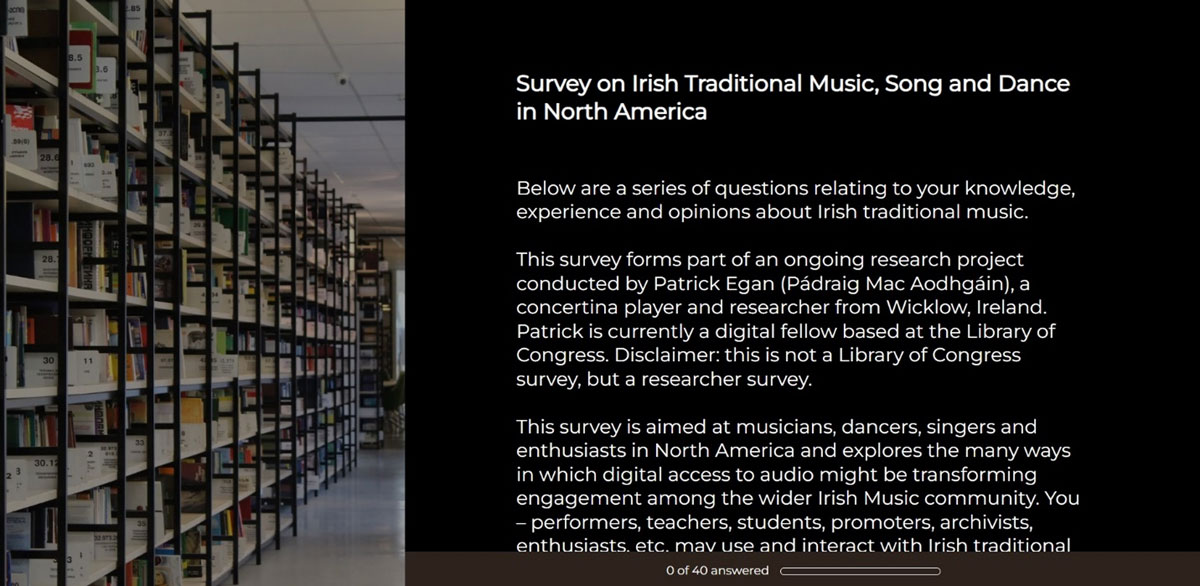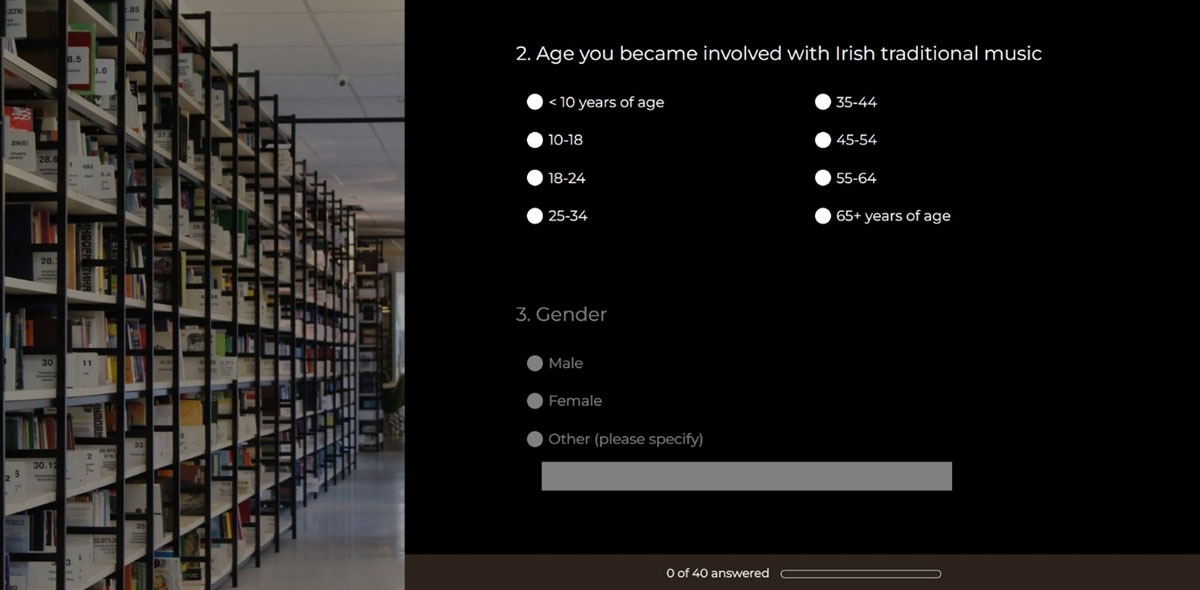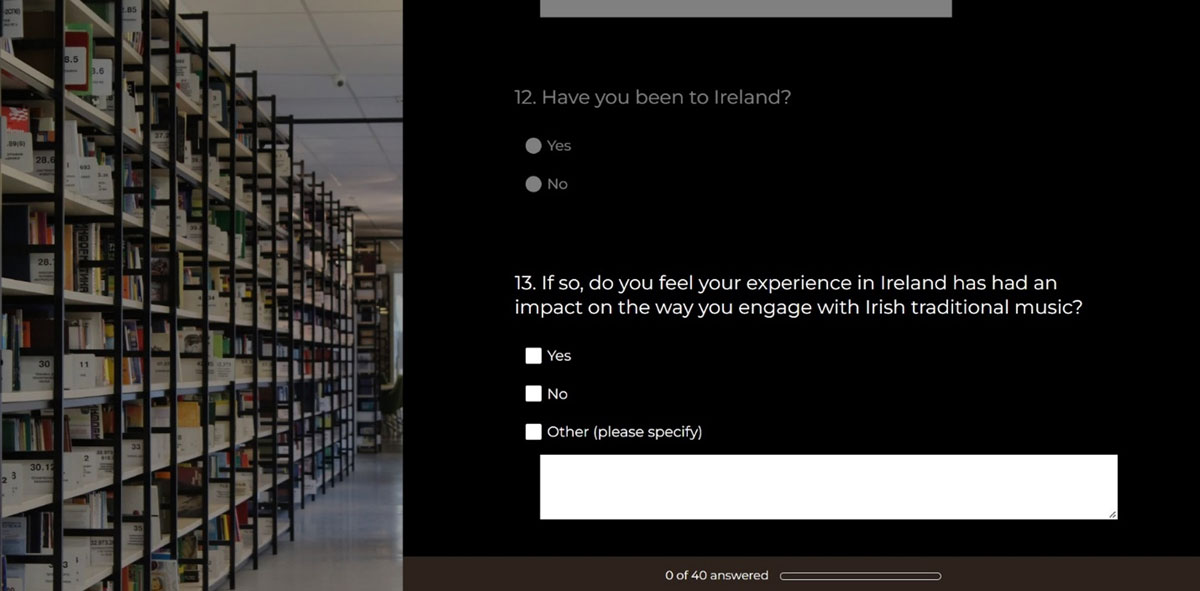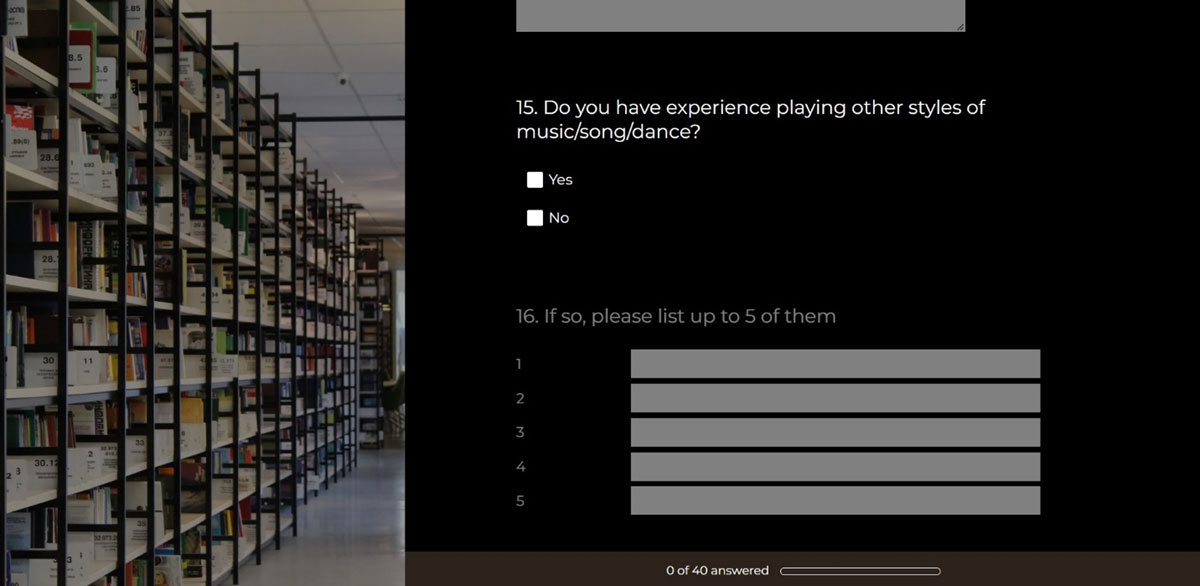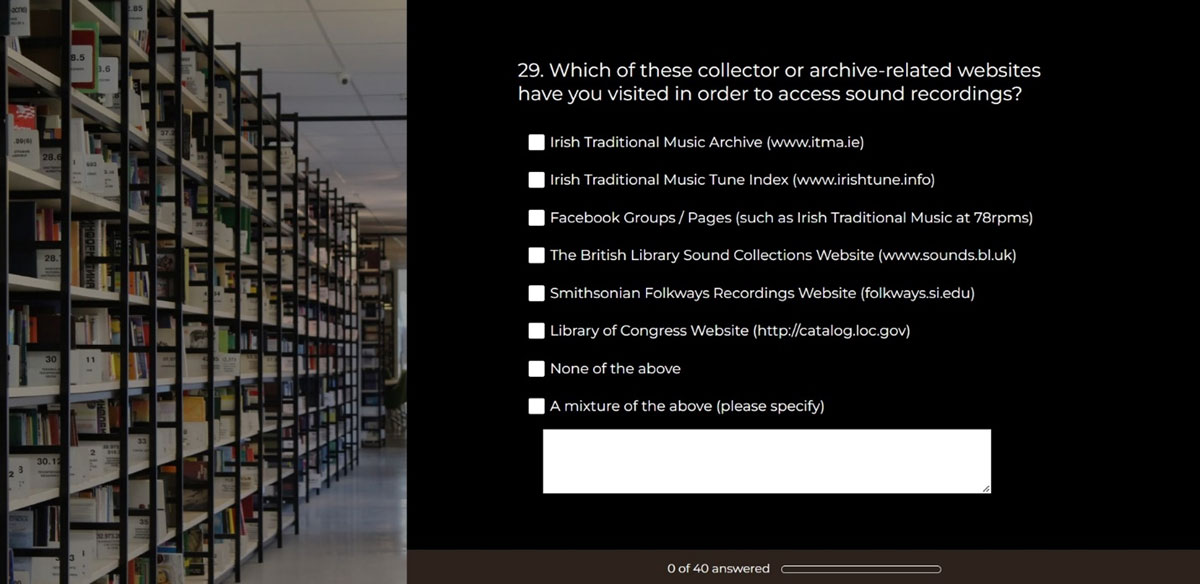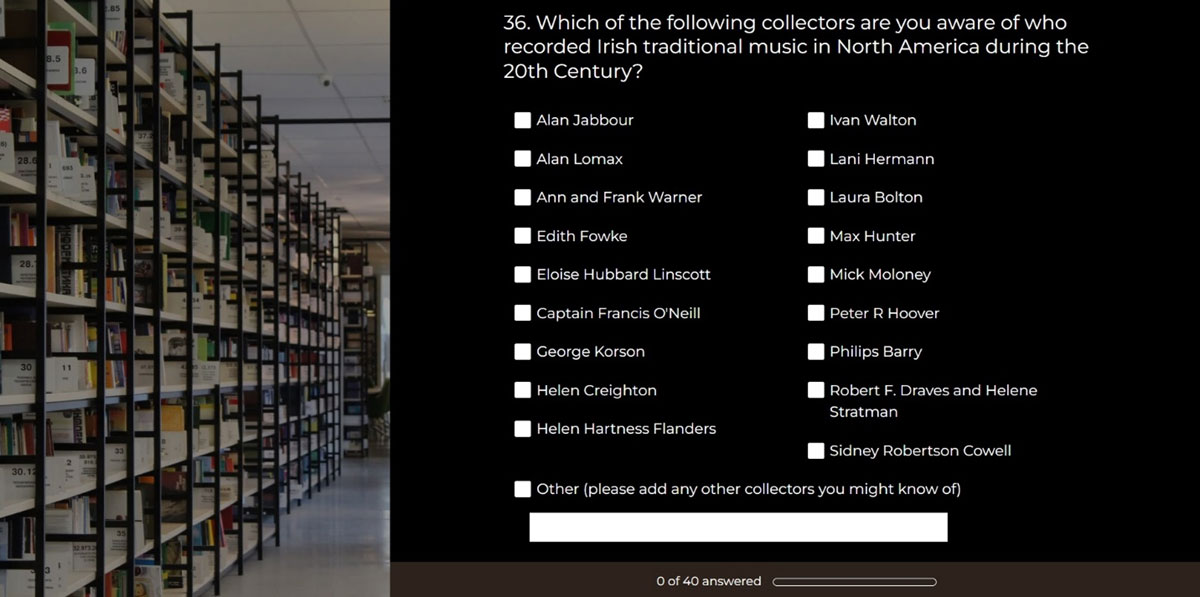Irish traditional music is a diverse, vibrant music genre that has now become popular worldwide. The author is a lecturer, digital humanist, and ethnomusicologist, as well as a recording artist who has performed within this tradition for over thirty years. The genre itself has enjoyed a resurgence since the 1960s, and this continued renewal is now supported by several thriving music communities and a plethora of archival materials that have been recorded and preserved both within Ireland and throughout many parts of the world. This resurgence has been brought about with the continued support of a wide range of communities—of ordinary singers, musicians and dancers, artists, revivalists, and other enthusiasts„who have ensured that the genre has evolved in a shared manner. As a community, it now includes both amateurs and fully fledged professional artists, who interact through formal and informal groups both online and offline, where they seamlessly cross boundaries of professionalism.
Whilst the tradition has often included many authoritative written, audio-visual, and audio sources for its transmission, sensibilities about approaches to its performance also continue to be shared enthusiastically through face-to-face interaction. As noted by Ward in 2016, in spaces such as the World Wide Web, online communities such as TheSession.org, “can act as a useful learning tool and catalyst in the transmission process,” but ultimately transmission is negotiated in live performance spaces called “sessions,” which are informal gatherings, where “all roads lead back to the tradition” (Ward 2016, 272). In the world of Irish traditional music then, both listening to and more importantly performing in different spaces to gather multiple versions of musical pieces are critical for the development of a musician or artist’s musical sensibility during their formative years, learning both music and the culture surrounding the tradition.
Archived material has been just one part of how Irish traditional music has been mediated for over one hundred years. However, the activity of placing focus on the primacy of the recording may sometimes become antithetical to the modes by which the tradition has been evolving. One archivist, themself a performer within the tradition, explains that “having one authoritative version of the tune [for retrieval purposes] denies the individuality, uniqueness, and personalization that is a part of Irish traditional music” (Weissenberger 2014, 497). In Ireland, in fact, the very meeting point where recorded materials become used by ordinary musicians has been seen as somewhat of a negotiation when it comes to the development of local musical style. Fairbairn, for example, notes that,
[t]here is an integrity about the practitioners of [these] styles, who employ a form of musical expression inherited from and evolved among local musicians and players in the family. It is the exclusivity of this relationship between an individual and the music of his or her area which imparts the great value of the resulting musical styles, and the respect and regard they command today. (Fairbairn 1994, 577)
It is such respect and regard for those who have been able to inherit a local “style” in Ireland that does allow those ordinary community musicians to develop their music within the tradition. This activity plays out on both the amateur and professional levels, where approaches to learning and developing enculturation with the tradition emerge during the development of musical careers as practitioners engage widely with family, peers, and mentors (see Cawley 2020, 1).
For other communities of Irish traditional music in the North American continent, the experience has been different in notable ways. Research shows there are unique factors in this process that present both obstacles and opportunities to enculturation and learning. Waldron and Veblen, and Williams examined the experiences of practitioners whilst focusing more closely on those based in the United States (Waldron and Veblen 2008; Williams 2020). As part of their wider studies on the topic, they highlight the various ways that performers become accustomed to the tradition, and their overcoming of obstacles such as geographical distance by way of technologies. Through years of interaction with this community, the author has posited that the many activities of developing unique settings of tunes or songs were approached and experienced in many different contexts throughout North America. It was perceived that enculturation and interaction with Irish traditional music in such places can often be linked with interaction with colleagues who may travel from Ireland, but also those who live permanently beyond that geographical area.
This research project looks to interrogate the perceived role that digital resources are now playing for these communities outside of Ireland, using survey data as analysis. A focus is placed on musical practice in a broad sense, something Finnegan has referred to as leading to “a greater appreciation of how individuals and groups organize and perceive their activities at the local level” (Finnegan 2013, 8). To borrow a term from Small, in this research context then, performers are approached in terms of musicking, to understand localized activities, involving the individual ways by which North Americans personally engage with Irish traditional music in the digital age (see Small 1998).
Although these previous studies have focused on the use of analogue and digital audio amongst Irish traditional musicians for the purposes of examining the process of learning, few have moved the focus of digital engagement with archives. Through several years of travel between the United States and Canada, and in numerous locations, the author has understood the North American experience of access to Irish traditional music in different ways, in particular the insight that this experience can be wide ranging. For example, by attending numerous informal events during this time, particularly at performances of Irish traditional music “sessions,” colleagues were asked if they had engaged with audio collections of Irish traditional music at the Library of Congress, where the author had been completing a Fulbright fellowship that was focused on collections of music at the American Folklife Center. Answers were very often vague, but insightful—a few performers had listened to and utilized some of the recordings, but most had not actively pursued material from the Library. This understanding led the author to enquire if archival audio was useful to musicians in North America more generally.
Survey development
A survey was since conducted between June 2019 and September 2020 (six months since the Covid 19 pandemic had begun). Due to the circumstances brought about by the pandemic, and the shift in practices and activities within the Irish traditional music community, the survey data does not reflect overall changes within the musical landscape in North America for more recent times. Scholars have documented how musicians have shifted their musical practice during that time, especially in the North American context (Bobker 2021; Thompson and O’Brien 2022). However, in the year following the gathering of survey data, a series of online video-based interviews were conducted with a range of performers who were known to have participated in the survey. This work has been ongoing, and future research with these interviews will aid in illuminating the day-to-day activities of musicians who are based in a range of different musical communities across the continent.
The central question for this research survey focused on how performers of Irish traditional music, song, and dance in North America had been using digital tools and resources of Irish traditional music, both online and offline, with a focus on archival materials. The project was hosted on the website SurveyMonkey.com and distributed to participants across the continent in two ways (SurveyMonkey 2023). Firstly, a notice was posted on popular website forums of Irish traditional music. These websites included TheSession.org, ChiffAndFipple.com, Concertina.net, MandolinCafe.com, and other traditional-music-focused website forums (TheSession 2023; Chiff and Fipple 2023; CONCERTINA.net 2023; Mandolin Cafe 2023). Secondly, with the aid of personal contacts from the Midwestern region of the United States of America, a wide range of organizations in several geographical regions were contacted. One organization, Comhaltas Ceoltóirí Éireann, which means “society of musicians” in the Irish language, aims to promote Irish traditional music throughout the world, and has many branches within the North American continent. (Established in 1951, Comhaltas is an Irish language word that translates as “membership.” Established in 1951, the organization describes itself as “the largest group involved in the preservation and promotion of Irish traditional music” [see Comhaltas 2023].) Information about the survey was also disseminated through Facebook groups and Twitter.com, and contacts were also reached using telephone calls.
Sampling and coding issues
Whilst the survey did connect with 528 respondents, some sampling issues were encountered during the development of the survey interface. For example, it was discovered that during the process of contacting organizations, institutions such as the Library of Congress required that the survey be optimized for respondents with disabilities. As the original survey had already been activated, it was not possible to include this optimization. This perhaps contributed to a lack of results from that potential audience.
Sampling bias was reduced in several ways. For example, connecting with practitioners in a wide variety of platforms relating to social media, forums, and group mailing lists ensured that representation was broad, and that feedback could support the goals of the survey research. In addition, by presenting the research in a way that encompassed musicians, singers, dancers and enthusiasts, the sample could also include performers in the widest sense, along with those who may not have been “performing” music on the scene in a conventional way (for example radio producers). Such respondents may otherwise have held valuable insight into the research.
The website that hosted the survey—www.surveymonkey.com—includes functionality to use several tools for the digital visualization of collected data. For some research questions, it was possible to create accompanying visualizations on the website as data was being gathered (SurveyMonkey 2023). However, several processing issues arose when testing the usefulness of these tools for other results, such as the limitations of choice of representative chart that could be produced when attempting to account for complex results. For example, in Figure 2, a plethora of genres were identified by respondents when asked about their experiences with music. The options available for visualization on the survey website did not represent these genres appropriately, as hundreds of results rendered basic charts illegible. As a result, a decision was made to develop each digital visualization using the software library D3.js, accommodating text in more sophisticated charts. Each visualization and related code were then made available on a personal website, www.patrickegan.org (Egan 2023).
Before the survey was sent to most organizations, a link to the online form was provided on a discussion board of the popular Irish traditional music website TheSession.org. This allowed the author to test if the survey was working correctly, and to identify any errors that may have occurred in the survey design. As feedback grew on this discussion, a few insightful comments appeared. For example, processing issues appeared within some questions, such as the inability of users to provide extra information for multiple choice questions that did not allow for open text feedback. During the first month of this initial test, the problem had been identified and was rectified throughout the survey.
Survey results
Demographically, of the 528 responses, 206 identified as female, 310 as male, and three as nonbinary or other. The first section of the survey revealed interesting insight into performers’ personal experiences in musical development, and the second section focused more closely on their interaction with archival resources. Even though the Irish Traditional Music Archive website (an institution based in Dublin, Ireland) was identified as the most popular online resource for musicians learning Irish traditional music, greater insight into wide-ranging activities of North American performers was encountered (ITMA 2023a). From the survey overall, a plethora of other internet resources were identified by survey participants, which led to greater insight into the range of approaches to audio material and a general understanding of the musical landscape in this region.
Responses involved people from a range of ages (see question in Figure 2 [Appendix A]). But of interest was that the average age of all respondents to the survey is weighted to being at 50% over the age of 55 (see Figure 1, top pie chart). Similarly, a large percentage of respondents answered that they became involved in Irish traditional music after the age of eighteen.
The use of the internet has been important for performers in North America for several reasons. In response to the open-ended question, “If using theinternet has been a big impact on your musical development and musical life, how has that happened?” out of 437 answers, 69 respondents cited the ability to learn multiple versions of tunes as a big impact on musical development. Interestingly, one dancer noted how access to digital video had been “incredibly helpful” for “seeing other styles and technique.” These results might be indicative of a need for practitioners in North America to access a diversity of resources.
Some probing questions revealed specific resources that the Irish traditional music community utilized over the course of their interaction with the genre. For the question, “Which internet resources have you used to share audio recordings?” participants were given a total of sixteen choices to select from, which the author had felt were well known, but respondents were also given the opportunity to indicate “Other” resources with which they have shared audio recordings on the internet. As expected, email was by far the most common form of sharing audio. Ward’s research in the Irish context found that the most popular web resource was TheSession.org, and performers across North America also cite this website as a most used resource (Ward 2016, 15). In this survey, many respondents also indicated that websites such as Facebook and Soundcloud.com had been used. However, a large range of responses further indicated that audio is shared in many other ways, and in particular the use of CDs continues to be a popular format, which indicates that the landscape is quite varied about habitual usage and activities that involve digital technology. It was perhaps most surprising that the total number of various resources that had been used by this survey sample was nearly at sixty, indicating a wide array of websites that are used by performers across the United States and Canada. In comparison with Ward’s 2016 survey, several North American responses also indicated that they made use of IRTrad Mailing List and Irish-Music.net, important Web 1.0 resources for practitioners in the region.
The survey also attempted to understand the connection between musicians and place, in particular their connection with Ireland, where Irish traditional music originated (see Figure 3 [Appendix A]). When asked about the importance of a connection to Ireland in their musical development, 385 out of 528 respondents had been to the country and cited it as having an impact on the way that they engage with Irish traditional music. Forty-seven respondents cited Ireland as a place that was formative. However, more indicative was that 126 revealed they had not been to Ireland, and of that 126, 39 indicated that other regions within the North American continent were formative in their musical development, and in some cases multiple locations in that region were formative.
Respondents demonstrated a plethora of experiences performing in other genres (see Figure 4 [Appendix A]). The dozens of music and dance genres in which Irish traditional music performers have experience ranges from Zydeco music to Bulgarian folk music. However, the most common experience outside of Irish traditional music was Western classical music (seen in Figure 2), where nearly 200 respondents had experience performing in this genre.
A part-visualization of the range of genre types generated from survey question: “Do you have experience playing other styles of music/song/dance?” Labels include Bluegrass, Classical, Country, Folk Music/Dance, English Country Dance, Choir, Jazz, Acadian, African, Gypsy and Ballroom. Results visualized using a “treemap” in D3.js and is accessible at https://www.patrickegan.org/d3-survey.
The metric of a large percentage of survey respondents being experienced with classical music in the North American context is particularly insightful, and I will return to this analysis later in the discussion.
Archives and audio
The second part of this survey focused on the use of archival audio. When asked “Have you ever visited an archive in person such as the Library of Congress, the British Library, or the Irish Traditional Music Archive to explore their collections of Irish traditional music?” a large proportion of respondents predictably responded “no,” that it was “too far away or inaccessible,” given the scale of the North American continent. However, for the follow-up question, “What is your opinion about these archives and the audio recordings that they hold?” most respondents responded positively about the importance and value of archives. In several cases—even if performers had not interacted with archives, the activity of preservation was commonly perceived to be an important factor for having archives of Irish traditional music.
Later in the survey, the question, “Which of these collector or archive-related websites have you visited in order to access sound recordings?” was asked to understand respondents’ uses of online resources (see Figure 5 in Appendix A). Respondents were given a list of websites to choose from (which prompted some ideas), but they also had an option to give an open response to the question posed (see Figure 3).
In all, a total of 37 other responses indicated other North American-based resources are used by these communities, but established archival resources such as the British Library and Library of Congress were not accessed by as many respondents in comparison with the Irish Traditional Music Archive. A US-based resource, IrishTune.info, was used by a large group of respondents, demonstrating its popularity in the region. Facebook groups also proved popular, which perhaps points towards questions concerning the ongoing and prevalent use of digital audio on social media platforms. Most notable among lesser used website resources were the Séamus Connolly Collection in Boston, the Ward Archives in Wisconsin, and the website, CeolÁlainn (see https://connollymusiccollection.bc.edu/; https://wardirishmusicarchives.com/; and http://ceolalainn.blogspot.com/). For those who responded that they had not used these websites, responses sometimes indicated that they were unaware of these resources.
This data demonstrates that perhaps archive-related websites in North America and outside of Ireland are not as popular with respondents as Irish-based ITMA, or even social media groups. Investigation of this insight is beyond the scope of this paper but the subject warrants further study.
Improvements and archival collections
The author also posited that the quality of respondents’ experiences in using website audio collections varied, and several personal communications with performers of Irish traditional music during the development of the project supported this position. Therefore, the final section of the survey focused on probing questions relating to the ways that archive materials would be presented in the future.
For example, participants were given a ranked question, “What improvements (if any, rank 1–5, move most important to the top or enter a number) would you suggest are most important for access to archival collections on the internet?” The responses indicated that the most popular improvement was perhaps obvious—the ability for respondents to be able to listen to audio recordings. Notably, there was also an expressed interest by respondents for more access to information that would inform them about what Irish traditional music is available within audio collections in archives, indicating a need for archives to provide access to listings of collections. On the other hand, participants showed less interest in knowing what instruments are featured in audio collections.
Information retrieval was understood by the author as an important activity for end users, as conversations with practitioners revealed that some found it difficult to find material, or to find material easily. Therefore, a ranked question was also asked of participants, “What informationdo you think should be most important in asearch for audio recordings on the internet?” As expected, most responses to this question indicated that access to material and versions of tunes would be a helpful feature when archives presented online resources. In question 34 out of 40, participants were asked the question, “What other information is important to you?” The answers demonstrated that there was a strong preference for “more older compositions that you haven’t already heard,” indicating that access to archived fieldwork may be important for musicians in this region.
A question also focused on gathering insights into respondents’ awareness of collectors of Irish traditional music in North America (see Figure 6 [Appendix A]). This was achieved by using a checkbox included for each instance where respondents knew about certain collectors—essentially either respondents had heard of a collector or not. Tellingly, some more well-documented collectors were known to respondents. For example, Alan Lomax, Captain Francis O’Neill, and Mick Moloney all featured as known to respondents; however, a notable number of respondents also did not select these collectors. This suggests that North Americans perhaps have no awareness about some collectors and possibly collections of audio material that resulted from fieldwork in the wider North American continent (see Figure 4).
The follow-up question sought to understand reasons for why respondents might be less familiar with collections of fieldwork materials. It was asked, “If you haven’t been very aware of these collectors of Irish traditional music in North America or haven’t engaged much withaudio material in archival collections,why do you think this is?” Answers varied, for example, some socio-cultural reasons were presented that described how respondents preferred person-to-person interaction. In other cases, respondents simply were not aware of the resources presented to them. And in other cases, respondents reflected on the issue that life commitments meant that they had lacked the time to connect. Lastly, it was notable that some respondents reflected on the issue that the “sheer volume” of material available was “overloading.”
Discussion and implications
On examination of the various analyses discussed above, the musical landscape of North America overlaps with the musical landscape in the Irish context, for several reasons. In particular, the suggestion that performers in the North American region may begin their musical lives in Irish traditional music at a much later juncture in life is an important difference between both contexts that may be starting to converge. Cawley, for example, demonstrated that in an Irish context, the formal study of Irish traditional music has only in recent years become more commonplace within second- and third-level education (Cawley 2020). In this survey, a large percentage of respondents answered that they became involved in Irish traditional music after the age of eighteen, demonstrating that in North America, in broad terms, participation within this genre of music has not emerged until after formative years.
On the connection between practitioners and place, it was assumed that a large percentage of North American practitioners would have visited Ireland at some point and made visits there for musical development. However, from the survey results, it is suggested here that for some, their experience of Irish traditional music is less guided by their connections to Ireland by circumstance or otherwise. As a result, many cited areas in North America that were formative in their musical development, revealing a particularly North American-centric interaction with Irish traditional music.
In Ward’s survey, 53.7% of respondents performed other styles of music, whilst between 40–50% of those respondents played Western Art music (Ward 2016). In contrast, this survey revealed that most respondents had experience “playing other styles of music/song/dance” and that 432 out of 528 responses (81.8%) played in other styles. Of the 528 respondents, 198 (37%) performed Western Art music. Whilst Ward’s sample may not be wholly indicative of the Irish experience for comparison here (about 20% of respondents were American), this research does indicate that Irish traditional musicians in North America have a strong background in this genre of music.
From the second section of this survey, it is also clear that North American archives are seen by the community as an important part of the landscape of Irish traditional music, but there is evidence that they are underutilized, and perhaps for many reasons. Performers do use a very wide range of internet resources to engage with Irish traditional music. But in terms of archival audio, awareness of fieldwork audio in these archives is limited, even though there is an interest in engaging with material should it be made readily available and easy to access.
Even if digital archival audio resources in North America seems to be relatively unfamiliar to respondents, it is partially evident that archives such as the Irish Traditional Music Archive have been successful in connecting with practitioners in this region. This may be not only the result of digitization strategies with audio by the Archive but could also include modes of learning by the practitioners themselves. One possible explanation why the ITMA is so familiar to practitioners in this region is that North American performers may learn to read music notation when engaging with Western Art music prior to enculturation with Irish traditional music. This could therefore explain why they may be engaging more with digital resources such as the ITMA’s digital tool “Port” (ITMA 2019). Port (meaning “tune,” or “jig”) allows musicians to find simultaneous audio with note-by-note accompanying notation, essentially a digital interface for learning tunes through both notation and audio playback. Port has since been superseded by a software program entitled “Soundslice” (ITMA 2023b).
Research that is focused more exclusively on the daily music-making activities of Irish traditional music practitioners in North America is now beginning to grow, and scholars have provided helpful insights. For example, research by Waldron and Veblen, previously mentioned, allows us to begin to compare the musical landscapes of North America and Ireland (Waldron and Veblen 2008). They provide us with a deeper understanding of access and attitudes towards Irish traditional music in the region. Waldron and Veblen in 2008 revealed valuable insight into musical practices in “virtual communities” in North America (Waldron and Veblen 2008). Their work touches upon issues relating to geography—describing the challenges presented to performers in North America in learning Irish traditional music. Isolated learning is explored as a replacement for learning as part of a physical community, albeit for different reasons perhaps to the Irish context. As noted by Cawley, a significant amount of online activity is now becoming more prevalent within the Irish context (Cawley 2013, 292). Such insights may indicate an increasing alignment of practices for both communities and warrants further investigation.
In terms of personal development within Irish traditional music in North America, more recent studies have focused on socio-cultural experiences and aspects of the experience of accessing Irish traditional music. For example, Williams explores the North American experience through a brief description of her own journey into the genre (Williams 2020, 6). It is noticeable here that her activities in many cases reflect similarly on the findings arising from this survey data, especially for many respondents regarding their personal development. This research gives weight to the idea that practitioners in North America have a very different pathway into the Irish traditional music scene.
More recently, Bobker also investigated the impact that the Covid 19 pandemic had upon practices of Irish traditional musicians within North America (Bobker 2021). Bobker’s insightful analysis reveals several complex relationships with the use of technology for North Americans and adds to the growing literature in this area. Although this survey data and analysis does provide a strong basis for further research into this topic, interview data that was collected during the Covid-19 pandemic will later aid this investigation in future to understand the daily activities of practitioners in this region exclusively, their negotiation of education, acculturation, digital spaces, digital resources, and archives in general. Preliminary work on interview data is beyond the scope of this paper. However, it is hoped that some of this data will further highlight the many socio-cultural differences and convergences that may exist between Ireland and North America, providing more substantial findings for this initial investigation.
Limitations
There are many limitations with this study. The total response dataset of 528 was a substantial undertaking for a research project involving one scholar but is quite small given that there are thousands of practitioners within North America. For example, there are thirty-nine branches of the popular society Comhaltas Ceoltóirí Éireann based in the region, which would include a range of musicians, singers, dancers, storytellers, and enthusiasts (Comhaltas North America 2023). In addition, Irish traditional music is primarily an oral tradition, and it is highly likely that the survey missed members of the tradition who do not use the internet. This may have unintentionally skewed some of the findings towards those who interact with digital tools and archival resources more often.
The researcher is also an active member within this community, having travelled to, lived, and performed within North America for over twenty years. Care was taken to approach the research in a neutral manner as much as possible, and this was supported by regularly meeting with a variety of practitioners at formal and informal events to discuss issues surrounding the subject and to gain feedback relating to the survey design with a wide range of contacts whilst living in Washington DC and performing at venues across the country.
Whilst the survey contained forty questions in total, it was felt that an adequate balance was struck between gathering enough data and enabling the respondents to complete the form in a short space of time. In all, the average time taken to complete the survey was just above fifteen minutes with relatively few drop-offs during the process of responding. By having an extensive and broad-ranging set of respondents across North America, this survey provides a general overview of the experiences of practitioners. However, a more focused survey on high population centres of Irish diaspora may have produced different results. Further exploration is needed to gain insight into the experiences of practitioners in specific regions.
Conclusions and future work
While the sample range is broad and insufficient to make definitive conclusions on the use of digital tools and resources by Irish traditional musicians in North America, several key points may be presented. This survey and subsequent analysis bridge a gap in the literature on musicians outside of Ireland who interact with resources of Irish traditional music—by focusing specifically on the Irish traditional music community in North America and their interaction with archival sources of digital audio and the use of digital tools, the research reveals unique insight into the musical experiences of practitioners in the region.
It is suggested that the experiences of performers of Irish traditional music in North America reflect many similar aspects of interacting with technology and performance of the genre in Ireland. Conversely, it is also suggested that the formative experiences of performers in this region are quite different in some ways. In North America, 1) there is a high rate of experience performing Western Art music, contributing to the ability of practitioners to read sheet music; 2) practitioners in the region have tended to begin their musical training in Irish traditional music at an older age; 3) many have developed a substantial amount of formative musical training in other locations within that region demonstrating that their experience of Irish traditional music is less guided by their connections to place, revealing a particularly North American-centric interaction with Irish traditional music. These experiences are based on the socio-cultural experiences and musical development of practitioners.
Part two of the survey analysis suggests that some archives play a key role in musical lives. The Irish Traditional Music Archive in Dublin, Ireland is the most popular resource for most practitioners in the region. The analysis also suggests that there is a consensus that people want archives to continue, even though their knowledge of collectors is relatively low. Archival fieldwork is seen as an important source for many practitioners in the region. Archives are seen to be “too far away” or “inaccessible” for many respondents, indicating that archives within the region have not yet connected with the Irish traditional music community.
In terms of the activities of archival institutions with digital tools and resources, it is clearer that to meet the needs of practitioners in this region would require specific digital strategies for archives based on these findings. It is suggested that archives in this region could develop resources that are like those found within Ireland, to cater for the needs of the music community more adequately. This may not be through digitization and online dissemination alone, but possibly the insight provided by research in areas such as Digital Asset Management instead may prove more useful for archives. Digital Asset Management (or DAM), is a business process for information management for storing, organizing, and accessing digital content.
This early and broad survey begins an exploration of the digital landscape of Irish traditional communities in the United States. Future research will include analysis of interview data relating to respondents from this survey and will provide more insight into the experiences of musicians in North America during the Covid-19 pandemic. This initial exploration also provides a strong basis for further research into this topic, opening an area of enquiry into more in-depth analysis of the uses of digital tools, archival audio, and the experiences of Irish traditional musicians outside of Ireland. Overall, it should be useful to researchers, performers, web resource practitioners, archivists, archive managers, and policy makers alike.
Ethics and consent
This project was initiated when the author was an independent researcher, working on a larger research project at the Library of Congress in 2019, and continued when that residency ended in November 2019. Therefore, there are some notes to be made about the approach to ethical procedures.
Ethical clearance was not sought from the Library of Congress, as this was an extra cost not covered by the funding arrangement that was connected to another project. The scholar in this case followed ethical procedures by corresponding with an ethics committee at University College Cork instead.
This study was not related to health, social care, or children, and data analysis focused on survey answers from informants over the age of 18.
The survey introduction (available at https://www.surveymonkey.com/r/B7F626T and see Figure 1 [Appendix A]) provides a disclaimer that the research was not affiliated with the Library of Congress. It explains the reasons for doing the survey, that no question is mandatory, and that the informant identities would not be disclosed at any stage.
The survey form itself was constructed with the intention of including a broad range of options for survey participants. For example, for gender it was known in that in the Irish traditional music scene that a range of gender types needed to be accommodated, including male, female, and nonbinary.
As identities would not be disclosed and answers were sought from adults, it was considered that this survey did not carry major risks.
Research ethics guidance was also sought and developed through the Social Research Association (SRA), through their ethics online forum and the issue of ethics (benefits versus harm) and the processes (e.g., consent) have been discussed and considered for this research. For more information, see https://the-sra.org.uk/SRA/SRA/Ethics/Research-Ethics-Guidance.aspx.
Benefit and informed consent are the two key requirements of the Declaration of Helsinki – Ethical Principles for Medical Research Involving Human Subjects (https://www.wma.net/policies-post/wma-declaration-of-helsinki-ethical-principles-for-medical-research-involving-human-subjects/etc). I hereby declare that such principles were followed. In addition to following these principles, an ACCORD statement has also been signed, which lays out the principles for ethical research.
Competing interests
The authors has no competing interests to declare.
Contributions
Editorial
Special Issue Editors
Emmanuel Château-Dutier, Université de Montréal, Canada
Barbara Bordalejo, University of Lethbridge, Canada
Roopika Risam, Dartmouth College, United States
Section, Copy, and Layout Editor
A K M Iftekhar Khalid, The Journal Incubator, University of Lethbridge, Canada
Translation Editor
Davide Pafumi, The Journal Incubator, University of Lethbridge, Canada
Production Editor
Christa Avram, The Journal Incubator, University of Lethbridge, Canada
References
Bobker, Andrew. 2021. “Keeping the Tradition Alive: Irish Traditional Music Sessions During COVID-19.” Master’s thesis, Michigan State University. ProQuest Dissertations and Theses. Accessed November 9, 2023. https://www.proquest.com/docview/2549677964/abstract/4A933F62BB524EA1PQ/1.
Cawley, Jessica. 2013. “The Musical Enculturation of Irish Traditional Musicians.” Ph.D. diss., University College Cork. Accessed December 11, 2023. https://cora.ucc.ie/bitstreams/656309c6-92c2-46fb-96e9-a86b76bfeb74/download.
Cawley, Jessica. 2020. Becoming an Irish Traditional Musician: Learning and Embodying Musical Culture. New York: Routledge.
Chiff and Fipple. 2023. “Index Page.” Chiff and Fipple Forums. Accessed October 16. http://forums.chiffandfipple.com/.
Comhaltas. 2023. “Comhaltas Globally Promotes Traditional Irish Music Dance Culture for Students, Educators, Visitors, Musicians & Journalists.” COMHALTAS. Accessed November 10. https://comhaltas.ie/.
Comhaltas North America. 2023. “History.” COMHALTAS North America website. Accessed November 9. http://www.ccenorthamerica.org/about-us/history/.
CONCERTINA.net. 2023. “Anglo, English and Duet Concertinas and Music.” Accessed November 10. https://www.concertina.net/forums/.
Egan, Patrick. 2023. “D3 Survey.” Patrick Egan | Digital Humanist and Ethnomusicologist in Cork, Ireland (blog). Accessed November 9. https://www.patrickegan.org/d3-survey/.
Fairbairn, Hazel. 1994. “Changing Contexts for Traditional Dance Music in Ireland: The Rise of Group Performance Practice.” Folk Music Journal 6 (5): 566–599.
Finnegan, Ruth. 2013. The Hidden Musicians. Middletown, Connecticut: Wesleyan University Press.
ITMA (Irish Traditional Music Archive). 2019. “An ITMA Tune Resource.” Port. 23 August. Accessed November 9, 2023. https://web.archive.org/web/20190823224050/http://port.itma.ie/welcome.
ITMA (Irish Traditional Music Archive). 2023a. ITMA-The Well for Irish Traditional Music, Song and Dance. Accessed November 10. https://www.itma.ie/.
ITMA (Irish Traditional Music Archive). 2023b. “Learn: Learning Resources for Tunes and Songs.” ITMA – The Well for Irish Traditional Music, Song and Dance. Accessed November 9. https://www.itma.ie/collections-overview/learn/.
Mandolin Cafe. 2023. “Mandolin Café.” Accessed November 10. https://www.mandolincafe.com.
Small, Christopher. 1998. Musicking: The Meanings of Performing and Listening. Hanover: University Press of New England.
SurveyMonkey. 2023. “The World’s Most Popular Free Online Survey Tool.” Accessed November 10. https://www.surveymonkey.com/.
Thompson, Ciara, and Kara Shea O’Brien. 2022. “From Hearth to Hard Drive: Well-Being Benefits of Online Irish Traditional Singing Sessions during COVID-19.” Health Promotion International 37 (Supplement_1): i4–i17. Accessed November 10, 2023. http://doi.org/10.1093/heapro/daab198.
The Session. 2023. “Traditional Irish Music on The Session.” Accessed November 10. https://thesession.org/.
Waldron, Janice L., and Kari K. Veblen. 2008. “The Medium is the Message: Cyberspace, Community, and Music Learning in the Irish Traditional Music Virtual Community.” Journal of Music, Technology & Education 1 (2–3): 99–111. Accessed December 11, 2023. http://doi.org/10.1386/jmte.1.2and3.99_1.
Ward, Francis. 2016. “Processes of Transmission in Irish Traditional Music: Approaching a Virtual Orality.” Ph.D. thesis, Limerick: University of Limerick.
Weissenberger, Lynnsey. 2014. “When ‘Everything’ Is Information: Irish Traditional Music and Information Retrieval.” In iConference 2014 Proceedings. iSchools. University of Illinois. Accessed November 9, 2023. http://doi.org/10.9776/14131.
Williams, Sean. 2020. Focus: Irish Traditional Music. 2nd ed. New York: Routledge. Accessed November 9, 2023. http://doi.org/10.4324/9780429282256.

